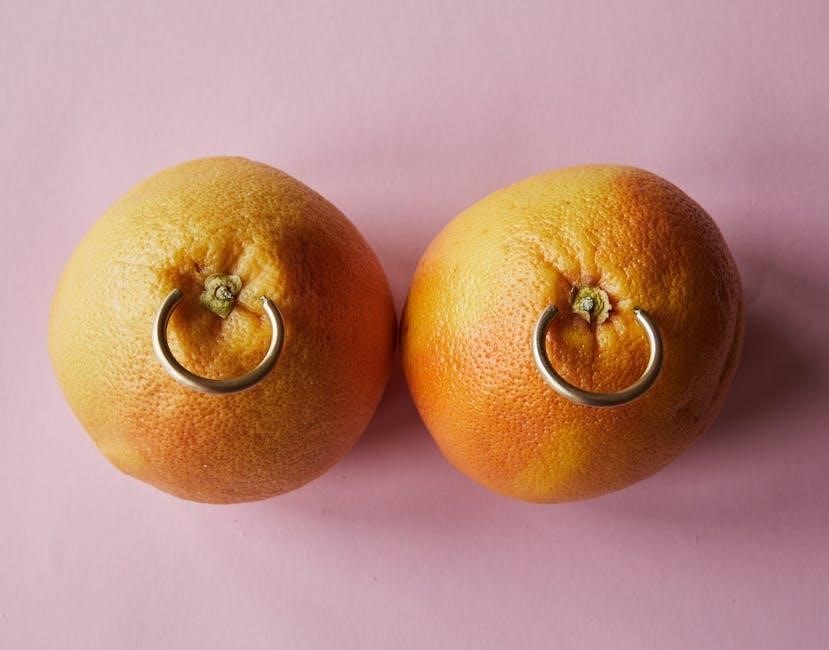Choosing the right size for nipple piercings is crucial for comfort and aesthetics. Typically‚ 14 gauge is standard‚ but anatomy and style preferences play a significant role. This guide covers key measurements‚ jewelry types‚ and professional tips to help you make informed decisions for a perfect fit.
Understanding the Importance of Proper Sizing
Proper sizing is essential for comfort‚ healing‚ and aesthetics in nipple piercings. A incorrect gauge or length can lead to discomfort‚ irritation‚ or even complications. The right size ensures the jewelry sits comfortably‚ allowing proper blood flow and promoting healing. Improperly sized jewelry may cause tightness or sagging‚ affecting both appearance and health. Consulting a professional piercer helps determine the ideal fit based on anatomy and personal preferences‚ ensuring a smooth healing process and long-term satisfaction. Proper sizing is the foundation for a successful and enjoyable nipple piercing experience.
Overview of Nipple Piercing Jewelry Options
Nipple piercing jewelry offers a wide range of styles to suit personal preferences and anatomical needs. The most common options include barbells‚ rings‚ dangles‚ and plugs. Barbells are the standard choice‚ available in various lengths and materials like titanium or gold. Rings provide a stylish alternative‚ while dangles add decorative flair. Plugs offer a snug fit for a minimal look; Each style caters to different lifestyles and aesthetics‚ ensuring there’s something for everyone. The choice of jewelry should align with comfort‚ healing requirements‚ and personal taste‚ making it essential to explore all options before deciding.

Basic Concepts of Nipple Piercing Sizes
Nipple piercing sizes focus on gauge‚ length‚ and diameter. Gauge measures thickness‚ with 14-16G being common. Length and diameter ensure comfort and proper fit for individual anatomy.
Gauge: What It Means and Why It Matters
Gauge refers to the thickness of the piercing jewelry‚ with lower numbers indicating thicker pieces. For nipple piercings‚ 14G is standard‚ though 16G is often used initially. Gauge matters because it affects comfort and safety. Thicker gauges are more durable but may feel bulky‚ while thinner gauges are lighter but less sturdy. Choosing the right gauge ensures proper healing and long-term comfort. A professional piercer can help determine the ideal size based on your anatomy and lifestyle‚ ensuring a balance between aesthetics and functionality for optimal results.
Length and Diameter: Key Measurements for Comfort
Length and diameter are critical for ensuring comfort and proper fit in nipple piercings. Jewelry that is too short may cause discomfort or irritation‚ while excessively long pieces can rub against clothing. The diameter‚ or thickness‚ of the jewelry is often tied to the gauge‚ with lower gauges being thicker. Proper measurements ensure the jewelry sits comfortably without putting pressure on the piercing. Consulting a professional piercer is essential to determine the ideal size based on individual anatomy. Accurate sizing promotes healing and long-term comfort‚ making it a priority for both functionality and aesthetics.

Popular Jewelry Types for Nipple Piercings
Barbells‚ rings‚ and dangles are popular choices for nipple piercings‚ offering versatility in style and comfort. Barbells are the most common‚ especially in 14 gauge‚ due to their durability and ease of use.
Barbells: The Most Common Choice
Barbells are the most popular jewelry option for nipple piercings due to their durability and versatility. Typically‚ they come in 14 gauge‚ which is ideal for most piercings. The straight barbell design allows for easy insertion and removal‚ making it a practical choice for both initial piercings and healed jewelry. The length of the barbell is crucial‚ as it must accommodate the individual’s anatomy and any potential swelling during the healing process. Initially‚ a longer barbell may be used‚ which can later be replaced with a shorter one once the piercing is fully healed. Barbells are also available in various materials‚ including titanium and gold‚ catering to different preferences and sensitivities. Many piercers recommend starting with a high-quality barbell to ensure comfort and proper healing. Additionally‚ barbells come in different styles‚ such as curved or threaded‚ offering aesthetic variety while maintaining functionality. Overall‚ barbells remain the go-to option for their balance of comfort‚ durability‚ and style.
Rings: A Stylish Alternative
Rings are a fashionable and popular choice for nipple piercings‚ offering a unique aesthetic compared to barbells. Typically available in 14 or 16 gauge‚ they provide a sleek‚ circular design that can enhance the appearance of the nipple. Rings are often preferred for their visibility and style‚ though they may be less discreet than barbells. Made from materials like titanium or gold‚ they are durable and hypoallergenic‚ ensuring comfort. However‚ rings can be more challenging to insert and remove‚ and they may require more maintenance during the healing process. Proper fit is essential to avoid irritation‚ making professional guidance crucial for selecting the right size and style.
Other Styles: Dangles and Plugs
Beyond barbells and rings‚ dangles and plugs offer unique styling options for nipple piercings. Dangles are decorative pieces featuring charms‚ gems‚ or other embellishments‚ adding a personalized touch. They are often available in 14 or 16 gauge and provide a playful‚ eye-catching aesthetic. Plugs‚ on the other hand‚ are solid‚ cylindrical pieces that sit flush against the skin‚ creating a clean‚ minimalist look. Both styles are versatile and can be tailored to suit individual preferences. Proper sizing and fit are crucial to ensure comfort and prevent discomfort. Consulting a professional is essential to determine the best style and size for your anatomy and personal style.

How to Measure for the Right Size
Use a gauge card for precise measurements or consult a professional piercer. Proper sizing ensures comfort and healing‚ as ill-fitting jewelry can cause discomfort or complications.
Using a Gauge Card for Accuracy
A gauge card is a essential tool for determining the correct size of your nipple piercing jewelry. It helps measure both the gauge (thickness) and the length of the jewelry accurately. By comparing your current jewelry to the gauge card‚ you can ensure a proper fit and avoid discomfort or complications. This method is particularly useful for those who prefer to measure at home. However‚ for precise results‚ consulting a professional piercer is always recommended‚ as they can provide expert guidance and ensure the best fit for your anatomy and preferences.
Professional Measurements: Consulting a Piercer
Consulting a professional piercer is the most reliable way to ensure accurate measurements for your nipple piercing. Piercers use specialized tools‚ such as gauge cards‚ to determine the correct size and fit for your anatomy. They consider factors like nipple size‚ jewelry style‚ and personal comfort to recommend the best options. Professional measurements also help prevent complications and ensure proper healing. By leveraging their expertise‚ you can avoid guesswork and achieve a secure‚ comfortable fit tailored to your unique needs. This step is crucial for both initial piercings and upgrading your jewelry in the future.

Factors Influencing Nipple Piercing Size
Anatomy‚ gender‚ and personal style significantly influence nipple piercing size. Body structure and natural proportions guide gauge and length choices‚ while individual preferences shape jewelry selection for optimal comfort and aesthetics.
Anatomy: How Body Structure Affects Size
Nipple and areola size‚ chest anatomy‚ and natural proportions significantly influence piercing size. Larger nipples may require longer jewelry‚ while smaller nipples need shorter lengths for comfort. Body structure determines the optimal gauge and barbell or ring length‚ ensuring proper fit and aesthetics. A professional piercer assesses individual anatomy to recommend the best size‚ avoiding discomfort or complications. Anatomy plays a crucial role in achieving a balanced‚ comfortable‚ and visually appealing piercing‚ making personalized measurements essential for success.
Gender Differences in Nipple Piercing Sizes
Gender differences in nipple piercing sizes are often influenced by anatomy and personal preference. Men typically opt for thicker gauges‚ such as 14G‚ to accommodate larger nipple structures‚ while women may prefer 16G for a more delicate look. However‚ these are general guidelines‚ and individual anatomy plays a significant role. A professional piercer can assess and recommend the most suitable size for comfort and aesthetics‚ ensuring the piercing complements the body’s natural proportions. Ultimately‚ gender norms should not dictate size choices; priority should be given to personal comfort and anatomical fit.

Choosing the Right Material
Choosing the right material for nipple piercings is essential for comfort and safety. Titanium is a popular choice due to its biocompatibility and durability. Gold and other precious metals are also options‚ though they may have specific pros and cons. Consulting a professional piercer helps determine the best material for your unique needs.
Titanium: A Popular Choice for Safety
Titanium is a top choice for nipple piercings due to its exceptional biocompatibility‚ making it ideal for sensitive skin. It is lightweight‚ corrosion-resistant‚ and durable‚ ensuring long-lasting wear; Many piercers recommend titanium for initial piercings because it reduces the risk of allergic reactions and promotes healing. Additionally‚ titanium is available in various styles and finishes‚ offering both functionality and aesthetic appeal. Its hypoallergenic properties make it a safe option for most people‚ especially during the critical healing phase. This material is highly recommended for its safety and versatility in nipple piercing jewelry.
Gold and Other Precious Metals: Pros and Cons
Gold and other precious metals‚ like 14k or 18k gold‚ are popular for nipple piercings due to their luxurious appearance and durability. They are biocompatible and suitable for long-term wear‚ especially for healed piercings. However‚ gold jewelry can be more expensive and requires proper care to maintain its quality. Some individuals may experience allergic reactions to certain alloys‚ though high-quality gold is generally safe. While not recommended for initial piercings due to cost and maintenance‚ precious metals offer a stylish and elegant option for those seeking a sophisticated look once the piercing is fully healed.

Professional Guidance and Recommendations
Consulting a professional piercer ensures accurate sizing and material selection. They use tools like gauge cards to recommend standard sizes‚ often starting with 14G or 16G for comfort and safety.
Why Consulting a Professional Piercer is Essential
Professional piercers use tools like gauge cards to ensure accurate sizing and material recommendations. They assess anatomy and lifestyle to customize choices‚ starting with standard sizes like 14G or 16G. Proper fit prevents discomfort and promotes healing. Their expertise minimizes risks of complications‚ ensuring a safe and satisfying experience.
Standard Sizes for Initial Piercings
For most nipple piercings‚ the standard gauge size is 14G or 16G‚ with 16G often recommended for initial piercings due to its thinner size‚ promoting easier healing. The length typically ranges from 1.6mm to 2.4mm‚ depending on anatomy. Straight barbells are commonly used for initial piercings as they are comfortable and easy to clean. These sizes are chosen to minimize discomfort and support the healing process. While 14G is popular for its durability‚ 16G is often preferred for new piercings to reduce swelling and ensure a smooth recovery. Always consult a professional piercer to determine the best size for your specific needs.

Common Mistakes to Avoid
Choosing the wrong gauge size or incorrect jewelry length can lead to discomfort and healing issues. Avoid selecting jewelry based solely on aesthetics without considering anatomy and comfort.
Choosing the Wrong Gauge Size
Selecting the incorrect gauge size is a common mistake that can lead to discomfort and healing complications. A gauge that is too small may cause tightness‚ while one too large can result in a bulky appearance. Typically‚ 14 or 16 gauge is recommended for nipple piercings‚ but individual anatomy varies. Choosing a gauge without professional guidance can lead to poor fit and potential irritation. It’s essential to prioritize comfort and proper healing by consulting a piercer to determine the ideal size for your body. Avoid guessing or selecting sizes based solely on aesthetics to ensure a safe and successful piercing experience.
Overlooking Jewelry Length and Fit
Neglecting the proper length and fit of nipple jewelry can lead to discomfort and hinder the healing process. Jewelry that is too tight may cause irritation or restrict blood flow‚ while overly loose pieces can catch on clothing or cause unnecessary friction. It’s crucial to ensure the jewelry fits snugly without being constricting. Initial piercings often require slightly longer barbells to accommodate swelling‚ gradually downsizing once healed. Consulting a professional piercer ensures accurate measurements and optimal fit‚ preventing potential complications and promoting a smooth healing journey. Proper fit is essential for both comfort and the longevity of your piercing.

Sizing for Healing and Aftercare
Proper sizing is vital for healing and aftercare. Initial jewelry should fit comfortably‚ allowing for swelling. Professional guidance ensures the right fit‚ minimizing complications and promoting smooth healing.
Initial Jewelry vs. Healed Jewelry
Initial jewelry for nipple piercings is typically larger to accommodate swelling and promote healing; A 14G or 16G barbell is common‚ made from safe materials like titanium. Once healed‚ individuals can switch to smaller gauges or decorative styles. Healed jewelry offers more flexibility in design‚ such as rings or dangles‚ but proper fit is still essential. Consulting a piercer ensures the right transition‚ preventing discomfort or complications. Understanding the difference helps maintain comfort and aesthetics during and after the healing process.

How Aftercare Practices Impact Jewelry Fit
Proper aftercare significantly affects how well nipple piercing jewelry fits. Using high-quality‚ safe materials like titanium or gold ensures comfort and reduces irritation. Regular cleaning prevents infections‚ which can cause swelling and make jewelry feel tight or misaligned. Wearing loose‚ non-restrictive clothing helps avoid putting pressure on the jewelry‚ which might cause discomfort or affect healing. Improper aftercare‚ such as neglecting to clean or tighten jewelry‚ can lead to complications. Consulting a professional piercer for adjustments ensures the jewelry remains comfortable and properly fitted throughout the healing process.
Proper sizing and professional guidance are key to a comfortable‚ stylish nipple piercing. Aftercare practices directly impact jewelry fit‚ ensuring long-term comfort and confidence in your choice.
Final Tips for Selecting the Perfect Nipple Piercing Size
Consulting a professional piercer is essential for determining the ideal size and style for your nipple piercing. Typically‚ 14G or 16G is recommended‚ but anatomy and personal preference play a role. Measure accurately using a gauge card or seek expert advice to ensure comfort and proper fit. Consider high-quality materials like titanium or gold for safety and durability. Avoid tight or loose jewelry to prevent discomfort. Aftercare practices‚ such as proper cleaning‚ will impact how well your jewelry fits over time. Take your time to research and choose a size that aligns with your body and style for the best results.
